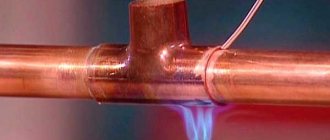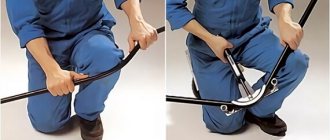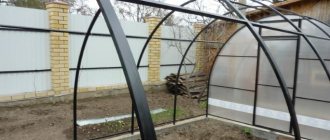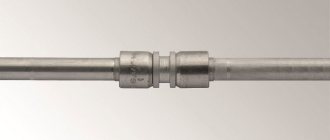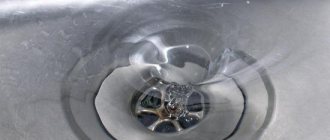- Features of low pressure polyethylene
- Allowable bending radius
- Melting temperature
- Bending methods
- In production
- Non-production
- We bend it with our own hands at home
- Precautionary measures
- Polyethylene grades
- Pipe bending algorithm
- Possible mistakes
HDPE pipes are pipes made of low-density polyethylene. There are two types of products: pressure, which are used in water supply, sewerage, gas supply systems, and non-pressure, intended for technical purposes. Also, HDPE pipes differ in wall thickness and outer diameter. The ratio of these two indicators is called SDR (Standard Dimension Ratio). The parameter is indicated in the product labeling. The higher its value, the thinner the pipe walls. The material goes on sale in coils, on reels, or in the form of lengths. Installation of pipe systems involves organizing rotating sections and combining parts of the pipe with bending at different angles relative to each other. We will tell you how to do this correctly in the article.
Using the molding machine
The first is to use a molding machine.
To quickly and correctly bend a HDPE pipe, you must first prepare a frame from the slab. This form is assembled taking into account the length of the pipe to be bent and its diameter. After assembly, it is necessary to carefully process the resulting frame using sandpaper so that its surface becomes smooth and free of defects.
Using a molding machine, we make a shell for the future plastic part from the prepared silicone. It is necessary to ensure that the HDPE pipe is securely fastened to the frame, and its surface is protected from dents, scratches, chips and other damage.
Now you need to insert the polymer pipe into the silicone shell and secure the resulting structure in a frame made of fiberboard.
The entire structure is placed on a molding machine for bending. Next, the product is heated, the plastic gradually softens and is placed on the frame, the HDPE pipe itself takes exactly the shape that is required. You should wait approximately ten minutes before removing the pipe from the frame until it has cooled completely.
Attention! Do not use the pipes before they are completely cool to prevent damage!
LLC DESIGN PRESTIGE
Heating method using a torch or hair dryer
Bending pipes using a hair dryer.
If you don’t have a molding machine, you can bend plastic pipes using a regular hair dryer or a gas torch. First, prepare a template from a fiberboard in the same way according to the shape of the future pipe, while it is recommended to avoid too sharp bends, that is, all turns should be smooth. Calculate in advance what kind of turn for the pipeline you need, where you can place the product during installation.
We mark the place where we will bend the profile plastic pipe, and point the heating device at the marked point. You should be very careful, since if the temperature is insufficient and the burner is too far away, the product simply will not heat up to the desired state and may simply break during bending, and if the temperature is too high and the heating device is too close, the polymer may ignite, which will also lead to damage to the water supply .
As it heats up, it is necessary to smoothly and slowly rotate the pipe around its axis so that all its sides are heated to the desired state. After the polymer becomes pliable, it is necessary to place it on the prepared template and bend it, carefully bringing the bend of the pipe to the desired angle. Make sure that the profile pipe does not break at the bend point.
The product must be held on the template until it has completely cooled, only then can it be removed and mounted.
You cannot try to change the bend of a pipe that is still soft, as this will lead to damage to the pipeline. If the resulting angle does not correspond to the required one, it is better to wait until the product cools down, and then repeat the entire procedure from the very beginning. But do not do this too often - such a polymer pipe may simply become unusable; it is better to immediately make the correct template.
LLC DESIGN PRESTIGE
Possible mistakes
If the technology for bending polyethylene pipes is violated, the result may be damaged material, as well as the inability to use blanks in pipeline installation.
- When bending a pipe without using a bending template, it is impossible to achieve the exact angle of the finished product.
- Bending a pipe that is not sufficiently heated to the required temperature range leads to a high risk of cracks appearing in the material (the minimum temperature at which HDPE becomes plastic is + 80 degrees).
- If the heating exceeds +130 degrees, deformation is possible: this is the temperature at which polyethylene begins to melt.
- If you ignore the uniform rotation of the workpiece around its axis, the wall may break when it is bent (not the entire area required for bending is heated).
- Removing a workpiece from the molding template that has not completely cooled will lead to deformation of the product and a change in the specified bend angle, which will make accurate assembly of the pipeline impossible.
What type of heating tool should be used?
Polyethylene is a capricious material; to bend it, it is better to take high-quality equipment, otherwise there is a risk of quickly replacing the pipe with a new one. Therefore, when choosing heating equipment, pay attention to the following:
- There must be excellent temperature control so that you can control the heating level; there must be air flow adjustment; it is desirable to have several modes. If you are not sure which one to work on, it is best to test it first on a small piece of pipe, which you can then throw away; the kit should include nozzles for gluing the pipe.
Bending the pipe with your hands is impossible, so don’t try to do it this way, you’ll just damage it and that’s it.
If you do not have the opportunity to purchase heating equipment, then first think about where and how the pipe should go during installation, and when purchasing it, simply ask the seller to perform such a service. Usually there is no problem here; the cost of such bending is quite low. But if you are laying pipes, for example, in a country house, then a gas burner or a hair dryer will not be superfluous in your household, so it is better to purchase them right away, they will be needed not only when bending the water supply, but also when performing other work.
Share a useful article:
Related Articles: Featured Articles
Heating from DESIGN PRESTIGE LLC Type: water here > resant.ru/otoplenie-dachi.html
note
Our company DESIGN PRESTIGE LLC is part of the non-profit organization ANO INTERREGIONAL BOARD OF FORENSIC EXPERTS. We also provide independent construction technical expertise services.
When installing sewer and water pipes, the question often arises: how to bend a plastic pipe correctly without damaging it? Many people believe that only professionals can do this, but in reality everything is much simpler, although some tools will need to be purchased.
Such temperature bending (and it is best to bend pipes when exposed to high temperatures) allows you to place the water supply system exactly where it is needed, without resorting to numerous cuts and connections. Temperature bending, and it is best to bend pipes when exposed to high temperatures, allows you to position the water supply exactly in the place where it is needed. Let's find out how you can bend a HDPE plastic pipe at home, what kind of tool is needed for this. Do-it-yourself bending process Pipe bending diagram. In order to bend a profile plastic pipe, you must first prepare the following tool: a molding machine ;building hair dryer (with the ability to precisely regulate the temperature); gas burner; fibreboard; template; silicone for the shell. The bending process can be carried out by two methods, we will consider each of them separately. Using a molding machine The first is the use of a molding machine. To quickly and correctly bend a HDPE pipe, you must first prepare a frame from the slab. This form is assembled taking into account the length of the pipe to be bent and its diameter.
After assembly, it is necessary to carefully process the resulting frame with sandpaper so that its surface becomes smooth and free of defects. Using a molding machine, we make a shell for the future plastic part from the prepared silicone. It is necessary to ensure that the HDPE pipe is securely fastened to the frame, and its surface is protected from dents, scratches, chips and other damage. Now you need to insert the polymer pipe into the silicone shell, secure the resulting structure in the fiberboard frame. The entire structure is placed on a molding machine for bending.
Next, the product is heated, the plastic gradually softens and is placed on the frame, the HDPE pipe itself takes exactly the shape that is required. You should wait approximately ten minutes before removing the pipe from the frame until it has completely cooled. Attention! Do not use the pipelines before they have completely cooled down to prevent damage! Heating method using a torch or hair dryerBending pipes using a hair dryer. If you do not have a molding machine, you can bend plastic pipes using a regular construction hair dryer or a gas torch. First, prepare a template from a fiberboard in the same way according to the shape of the future pipe, while it is recommended to avoid too sharp bends, that is, all turns should be smooth.
Calculate in advance what kind of turn you need for the pipeline, where you can place the product during installation. We mark the place where we will bend the profile plastic pipe, and point the heating device at the marked point. You should be very careful, since if the temperature is insufficient and the burner is too far away, the product simply will not heat up to the desired state and may simply break during bending, and if the temperature is too high and the heating device is too close, the polymer may ignite, which will also lead to damage to the water supply .As it heats up, it is necessary to smoothly and slowly rotate the pipe around its axis so that all its sides are heated to the desired state. After the polymer becomes pliable, it is necessary to place it on the prepared template and bend it, carefully bringing the bend of the pipe to the desired angle.
Carefully ensure that the profile pipe does not break at the bend point. The product must be held on the template until it has completely cooled, only then can it be removed and mounted. You cannot try to change the bend of a pipe that is still soft, as this will lead to damage to the pipeline. If the resulting angle does not correspond to the required one, it is better to wait until the product cools down, and then repeat the entire procedure from the very beginning.
But don’t do this too often - such a polymer pipe may simply become unusable, it’s better to immediately make the correct template. What kind of heating tool should be? Polyethylene is a capricious material, it is better to take high-quality equipment to bend it, otherwise there is a risk of quickly replacing the pipe with new. Therefore, when choosing heating equipment, pay attention to the following: there must be excellent temperature control so that you can control the heating level; there must be air flow adjustment; it is desirable to have several modes. If you are not sure which one to work on, it is best to try it first on a small piece of pipe, which can then be thrown away; nozzles for gluing the pipe should be included in the kit. Bending the pipe by hand is impossible, so do not try to do it this way, you will just damage it and that's it.
If you do not have the opportunity to purchase heating equipment, then first think about where and how the pipe should go during installation, and when purchasing it, simply ask the seller to perform such a service. Usually there is no problem here; the cost of such bending is quite low. But if you are laying pipes, for example, in a country house, then a gas burner or a hair dryer will not be superfluous in your household, so it is better to purchase them right away, they will be needed not only when bending the water supply, but also when performing other work. Share this useful article: Similar articles:
The abbreviation for HDPE pipes means that they are made of polyethylene material that can withstand low pressure. From this we can conclude that such pipes are ideal for transporting various liquids and gases through them.
At the same time, HDPE pipes today are often used in the process of laying sewer systems, or as a pipeline through which water supply will subsequently pass. Also, this type of pipe can be used as a form of protection for communication cables laid underground or under water.
Bending methods
HDPE is both a very durable and flexible material. This allows you to heat the workpiece to a softened state, and then bend the pipe, giving it the required bend angle.
Production
For this purpose, special molding industrial equipment is used - high-precision molding machines.
Achieving a specific bend radius is calculated based on the ratio of the cross section to the outer diameter.
This is done in two ways:
- rolling a roller around a template with a given bending radius without filler;
- screwing onto a bending template using a mandrel inside that protects against damage.
Household
If it is impossible to use molding machines to bend HDPE pipes, less precise methods are used, based on the use of available equipment or improvised means for heating. The bending of the pipe, as in the industrial method, is carried out by forming a given angle according to a pre-made bending template
Using a hair dryer
A safe and effective method for doing the job at home. It is important to have a hair dryer of sufficient power with precise adjustment of the operating temperature.
- heating the bending area,
- forming (bending) the workpiece according to the template.
At a low operating temperature or a significant distance between the hair dryer and the surface of the material, the softening of the polymer will be insufficient, so there is a high risk that the pipe wall will deform or crack when bending.
Using a gas burner
According to the principle of operation, the method is an alternative to using an electric hair dryer. But this option is significantly inferior to the previous one in terms of safety: experience with such equipment is required.
If the burner is close to the polyethylene, it may melt or ignite.
The advantage is the possibility of use in places where there is no power supply, as well as the lower cost of purchasing a 200 ml cylinder for a gas burner (compared to a medium-power construction hair dryer).
Hot water treatment
The simplest, but ineffective method in the absence of a hair dryer or gas burner. At home, using hot water it is quite difficult to evenly heat the wall thickness, as well as the surface area required for bending. If the amount of work is small and the pipe diameter is no more than 50 mm, it is quite possible to use a regular kettle.
Hot water can be replaced with bulk materials, such as salt or river sand. It is necessary to heat them to the desired temperature, for example in a frying pan or baking sheet, pour them into the pipe and wait for the product to heat up. After this, carefully bend and let cool.
Why HDPE pipes?
From the description above, one gets the impression that HDPE pipes are almost an ideal option, which will come in handy for any business.
True, sometimes when working with pipes the question arises: how to bend them? Or, on the contrary, how to straighten it?
HDPE plastic pipe is considered a material that is very easy to damage if handled incorrectly. It is best to entrust this matter to professionals. Sometimes you still have to do this process yourself at home.
Is it possible to bend and straighten HDPE pipes?
With the right attitude and sufficient skills, HDPE pipe is very easy to bend and straighten.
The high temperature during the bending process can modify a section of pipe to the required state.
An HDPE pipe can be bent by hand, but to do this you need to have fairly decent physical strength and the proper degree of attention to everything that is happening. To achieve the best result, you should use a special tool.
How to bend and straighten a pipe?
It is more effective to choose basic and already proven methods. The forming machine allows you to bend HDPE pipe quickly and correctly.
To do this, before starting the bending process, it is necessary to prepare a support from the plate. At this stage, the desired shape for bending the pipe is achieved.
Then you need to sand the support to avoid defects on its surface. Next, a shell is made from silicone, which will serve as protection for the fasteners. After this, the bending process begins.
The HDPE pipe is sent into a silicone shell, while it is also secured with a fiberboard support.
Next, the entire structure is placed in a molding machine, where it is heated. In this process, any shape for the HDPE pipe can be achieved. Then you should let it cool.
A construction hair dryer and a gas burner perform similar actions, with the exception of minor nuances in the approach to performing this type of work.
It must be remembered that HDPE pipes should not be sharply bent or straightened, so as not to cause them to suddenly break.
It is also necessary to ensure that all equipment, tools and additional parts used are in working condition and of proper quality in order to avoid emergency situations during the process of bending and straightening HDPE pipes.
It happens that the installation of communication systems has to be carried out in such a way that some areas are located at a certain angle to each other.
If flexible polyethylene pipes are used during installation, then for their installation you need to stock up on special equipment or some devices. Today it is possible to create communications without complex work using welding machines. We will look at how this is done and how to bend the HDPE pipe during installation in this article. Content:
DIY bending process
There is not always hot sun, hot water and sand, a home bath or sauna. In this case, a hair dryer will come to the rescue of the home craftsman. With its help, you can bend a short piece, you can straighten a long piece for external plumbing, or you can bend it.
Required tools and materials
To perform bending you will need:
- construction hair dryer;
- workpiece;
- mittens;
- mandrel. The mandrel is made of bars stuffed onto chipboard, OSB, fiberboard (for small diameters).
Work progress
Bending technology:
- the workpiece is heated in the area that will be bent; for uniform heating, the workpiece must be rotated;
- then you need to smoothly bend the pipe, then lay it in the frame;
- let cool, stand for a few minutes;
- then remove and let sit for at least 15 minutes.
What are polyethylene products?
Currently, they are quite widely used in many fields of activity.
How does the name HDPE pipe stand for and what does it represent? This product is made of low-density polyethylene. The appearance of the pipes can be blue, black or gray, sometimes with longitudinal stripes.
Let's watch a video about the advantages and disadvantages of the pipe: Coloring does not have any effect on the technical characteristics of the products. Although, it so happens that blue pipes or those with stripes of the same spectrum are used for arranging water supply systems. The main advantages of HDPE equipment include the following:
- Light weight;Easy to transport;Corrosion resistance;Easy to install;The material does not react with water;Long service life;Affordable prices.
Products made from low-density polyethylene are used to create sewer systems and pipelines with drinking and industrial water. HDPE pipes are connected using fittings made of the same material.
Technologies for bending polyethylene products
All known methods of changing the shape of such pipes are based on the main properties of the material from which they are made. The polymer softens under the influence of strong heat and can take the shape we need. This can be done using heating devices:
- Construction electric hair dryer; Special molding machine.
Some craftsmen create homemade devices in the form of a spiral of copper wire, with the help of which they can also achieve deformation of the material. A special tool is also used to cut workpieces to the required length.
Physical cross-linking using X-ray irradiation.
Physical cross-linking produces PEX-C cross-linked polyethylene.
, such a pipe is treated
with irradiation with hard x-rays
.
The cross-linked polyethylene thus obtained is designated PEX-C
. The average percentage of such cross-linking is 78%. As a result of this method, the cross-linking of the material across the thickness of the pipe occurs unevenly: the outer surface has the largest percentage of molecular cross-linking, while the inner surface has the smallest. Broken parts can only be corrected using couplings. During production, no additional chemical additives are used to improve the characteristics of the pipe. Increased risk of microcracks.
Bend a pipe using a forming machine
To do this, you must first prepare a frame that will protect the workpiece from damage. It is made from fiberboard, taking into account the diameter of the bent pipe.
Bend a HDPE pipe using a forming machine
Further operations are performed in the following sequence:
- A silicone shell is made; A pipe is inserted into it and secured in a pre-made fiberboard frame; The entire structure is fixed in a molding unit; Heating of the polymer product and bending; Cooling of the workpiece.
It is very important that the surface of the frame does not have any unevenness or other defects; for this it must be well sanded using sandpaper.
Using a construction electric hair dryer
But what if the special equipment described earlier is not available? In this case, a hair dryer or a gas burner is used as a heating device. As in the previous method using a molding machine, you will need to make a template from fiberboard.
But then the technology is different. Let's consider step by step how to work with HDPE pipe in this case. And this is done as follows:
- The selected place is heated by the device; In order for heating to occur evenly, the product must be rotated slowly; The softened workpiece is installed in a pre-made molding frame; The pipe that has reached a certain bending angle is left to cool; The cooled workpiece is removed.
Using a hair dryer requires compliance with certain rules. For example, you need to be extremely careful when heating a pipe.
If the workpiece is far away from the heat source, the softening of the polymer will be insufficient, which can lead to incorrect deformation. Strong exposure to high temperatures or open flames can cause the material to ignite. Watch the video, bending using a construction electric hair dryer: If it was not possible to achieve the desired result the first time and the bending radius of the product does not correspond to the required one, then you need to wait for it to cool completely and only then repeat the entire operation from the beginning.
Forceful attempts to change the configuration of the workpiece before the material hardens can cause irreversible deformation and further use of the pipe will become impossible. To avoid this, making a template with sharp bends is also not allowed.
Calculation of the minimum diameter for a given length
For approximate calculations of the bending radius, you will need two rigid rulers of 30 and 50 cm in length (their choice depends on the magnitude of the bend). The procedure looks like this:
- First, the bend radius of the already formed pipe is measured, which must be copied onto the original workpiece.
- When measuring a strong bend, take a 30 cm ruler and apply it to the ends of the curved pipe, after which the distance between it and the middle of the workpiece is measured.
- For a small bend (longer pipe length), the same operations are performed with a 50 cm ruler, as shown in the photo below.
Retrieving data for calculation
*
A – interval (clearance), mm.
D – arc diameter, mm.
R is the radius to which the pipe is supposed to be bent, mm.
To understand what the required parameter R is, you should refer to the photo below in the text, which shows a sample of an already bent workpiece.
Based on the data obtained during measurements, you then need to select a suitable indicator of the radius (diameter) of the arc, the values of which can be found in specially prepared tables. They are posted in sources on the Internet (where various options for preliminary measurements are taken into account).
Using the burner
The principle of operation is similar to the previous one. But during the heating process, care should be increased tenfold, since the use of open fire significantly speeds up all stages of the operation. The main advantage of this method is the ability to carry out installation work in places where there is no power supply.
Bend with a torch
The price issue can also play a certain role, since purchasing one gas cylinder weighing 220 grams will cost ten times less than purchasing a medium-power construction hair dryer.
Chemical cross-linking under high pressure with laser processing.
Chemical crosslinking methods also include crosslinking with peroxides, in which polyethylene is pre-evenly mixed with peroxide
.
Cross-linking occurs in the extruder
in a molten state through exposure to laser light under high pressure.
This method gives 85% cross-linking. And most importantly, the properties of the material are the same anywhere, regardless of its thickness. This polyethylene is designated PEX-A
.
Kinks in such a pipe can be easily repaired with a hair dryer, but the pressure withstand rate is slightly lower than PEX-B. In terms of properties, PEX-A pipe
is the most elastic and flexible.
How to straighten a HDPE pipe
Most often, when installing an external water supply system, connecting pumping equipment to a well, or if it is necessary to carry out wiring in a local area, low-pressure polyethylene pipes with a diameter of no more than 180 millimeters are used. Manufacturers produce them in coils to facilitate transportation. This also makes it possible to lay pipelines of any length using as few connecting parts as possible.
But this method of storing pipes leads to their bending. Further use of the products requires preliminary straightening. This can only be done taking into account the properties of HDPE and its technical characteristics.
As you know, polyethylene is quite plastic and can soften when heated even from sunlight.
This property of the material is used when installing communication systems in the summer. It is enough to stretch the pipes and leave them for a while in the sun. Any creases caused during transportation and storage will soon disappear.
But how can you straighten a HDPE pipe at other times of the year? What equipment is used in such cases?
If the length of communication is significant, then special equipment is used in the form of a trolley with an aluminum frame. Elimination of bends on it occurs under the influence of rotating rollers. Straightening of small-length workpieces is possible using heating of its individual sections.
It is important that the equipment used for these purposes has:
- Several operating modes; Possibility of temperature adjustment; Air flow control.
Only properly selected equipment will allow HDPE pipes to be given the required configuration and minimize the use of fittings.
Chemical cross-linking by immersion in solution.
During chemical cross-linking under the influence of chemicals, hydrogen atoms are replaced in polyethylene molecules. One of these chemicals is silane (so-called silane cross-linking). The polyethylene pipe, leaving the extruder, “takes” a silane bath
, while the stitching goes from the outer and inner surfaces deep into the pipe wall.
As a result, the percentage of crosslinking is high on both surfaces, and low in the middle of the pipe thickness. The average percentage of crosslinking is approximately 75%. This material is usually designated PEX-B
. In terms of flexibility properties, such a pipe is less flexible than PEX-A. Broken parts can only be corrected using couplings. High pipe pressure.




